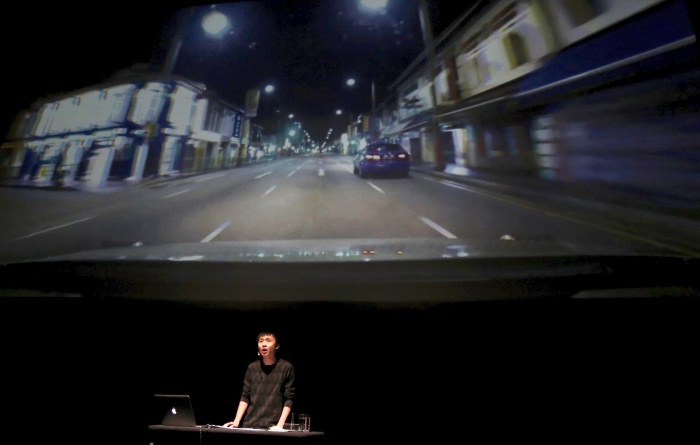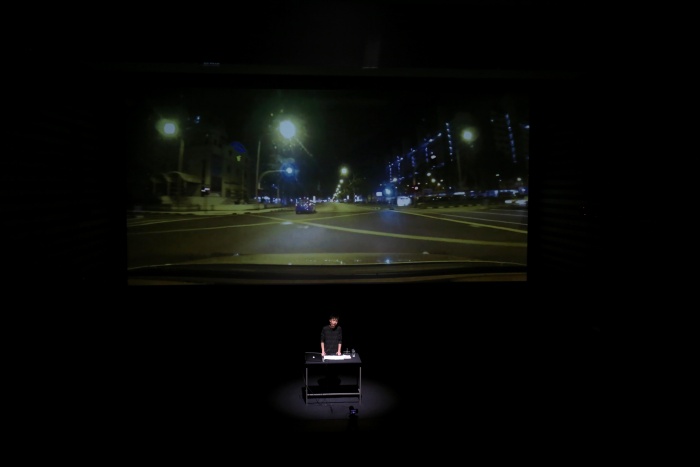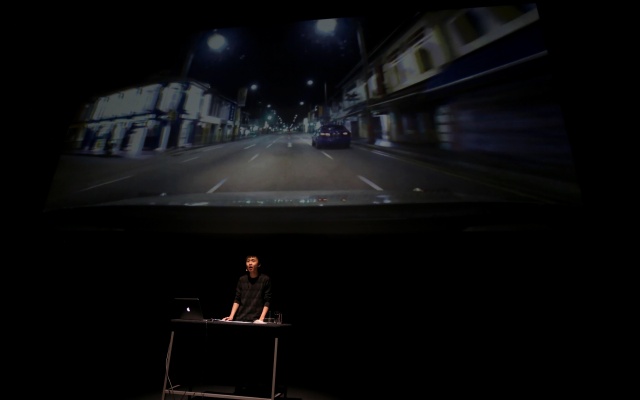
Performans Ho Rui An pt. "DASH". Zdjęcie: Marwan Tahtah. (c) Ashkal Alwan
1. Krzysztof Gutfrański begins the second paragraph of his editorial introduction to Obieg 5 (2017) with a casual reference to a certain “Russian witticism”: “only the future is certain – it is the past that is unpredictable.” For the first in this sequence of five footnotes, I sought to find out more information on the epigram. I don’t believe I knew it, or maybe I had forgotten it; either way, I felt embarrassed by my ignorance. Although it did seem immediately familiar – one recognizes the Russian humor: sarcastic and dark, but also so true and very funny! (Not that I have anything beyond a general knowledge of Russian history. As a child, I played with model T-34 tanks. In my youth I read some Dostoyevsky and Tolstoy, of course. And then there was Nabokov, but more on him later.) While the Russian witticism cited by Gutfrański certainly pertains to recent developments in Russia, as he shared with me in an email correspondence, in Poland, “We are obsessed with the past. And the current government is making the best postmodern use of this old Soviet joke” (email correspondence December 5, 2017).
Cursory googling led me to these points of varying interest:
(a) In the summer of 2017, the London-based Calvert 22 Foundation presented an exhibition curated by Monika Lipšic that was called – a slight variation on the above – “The Future is Certain; It’s the Past Which is Unpredictable,” and subtitled, “A group show on writing and rewriting history.” It included such artists as Emilija Škarnulyte, Jonas Mekas, Jura Shust, and Slavs and Tatars. See http://calvert22.org/future-is-certain/ (accessed 27 November 2017).
(b) In The American Historical Review, Lawrence W. Levine opens his article, “The Unpredictable Past: Reflections on Recent American Historiography,” with yet another version: “‘The future is certain’, a Soviet joke assures us, ‘it is only the past that is unpredictable’” (Vol. 94, No. 3, June 1989, pp. 671–679). Levine goes on to discuss how historians have long been comfortable with the fact that their practice was one of continual revision, but, somehow, something changed in the 1980s that put the “venerable craft of the historian in a state of crisis.”
(c) As a source for the assuring joke, Levine cites Steven Lukes, Marxism and Morality (Oxford, 1985, p. 146). That Gutfrański attributes the quip to Russia, whereas these academics referred to it as Soviet, must be contingent on the fact that the latter two were writing in the 1980s, coincidentally, the time just before the Soviet Union would collapse.
(d) In Terence Ball’s review of Lukes’s book (Ethics 97, no. 4, July, 1987, pp. 871–872), the observation is made that while Lenin and later Marxists were eager to ask, What is to be Done?, too few thought it worthwhile to consider, What, morally speaking, may Not be done?
Let me back track a bit. Gutfrański’s introduction, “The Aesthetics of Contingency,” lays out some coordinates to guide the reader through this issue’s many themes, which range from architecture and history to ghosts and risk management. When he invited me to contribute, my response was to ask if I could write about footnotes. Why? I thought the footnote had a certain subterranean quality that might resonate with a discussion of a reconstructed castle, and, also, I felt unqualified to contribute in a straightforward manner – not having visited Poland (yet), let alone the Centre for Contemporary Art. Generally speaking, the footnote supplements and/or complements; it can reinforce the main text, but it can also offer a subtle subversion. Part of how footnotes function is by detouring and digressing: they throw up information – some of it curious, some of it necessary, and some of it not very germane. They can be ironic. And then there is the relationship between footnotes and jokes.
2. Which brings me to Vladimir Nabokov (and strictly speaking, this isn’t a second note for Gutfrański’s introduction but a footnote within the first footnote). In the larger history of annotations, the Russian émigré definitely deserves a mention. While I cannot discourse in detail on the topic here, even if I were equipped to do so, let me offer a pair of citations to suggest some parts of the terrain. Alfred North Whitehead, Process and Reality: An Essay in Cosmology: “The safest general characterization of the European philosophical tradition is that it consists of a series of footnotes to Plato. I do not mean the systematic scheme of thought which scholars have doubtfully extracted from his writings. I allude to the wealth of general ideas scattered through them.” Originally published in 1929, early versions of Process and Reality contained many textual errors; the corrected version was edited by Griffin and Sherburne (New York: Free Press, 1979, p 39). Then there is Darian Leader’s Freud’s Footnotes (London Faber & Faber, 2000); however, I cannot cite Leader here without also recommending his especially witty Why Do Women Write More Letters Than They Post? (London: Faber & Faber, 1996), or his Lacan for Beginners (with illustrations by Judy Groves, Cambridge: Icon Books, 1995).
Returning to Nabokov: his 1962 novel, Pale Fire, is, to quote from musician and author Ted Gioia:
[O]stensibly the text of a poem of the same name by John Shade, with introduction and commentary provided by Charles Kinbote, as well as a supplementary index. A tragic human interest angle: shortly after Shade finished the composition of his 999 line poem, on July 21, 1959, he was murdered, apparently by an escapee from an institution for the criminally insane. In the aftermath of the crime, Shade’s neighbour Kinbote undertook to publish and explicate his friend’s final work. Then again, almost every one of these “facts” is open to second-guessing and dispute, and as the reader progresses through the novel – either moving sequentially through the pages, or moving back and forth between poem and notes – a range of alternative interpretations emerge. The neighbour Kinbote, for example, might really be an exiled Zemblan king, better known as Charles the Beloved, or perhaps a mad Russian professor – Nabokov, in an interview, nudged readers toward the latter interpretation – but another reading, also with some backing from the author, dispenses with Kinbote entirely, and makes him a construction of Shade. See http://www.postmodernmystery.com/pale_fire.html (accessed 27 November 2017).
Surely Pale Fire also deserves a place in a literary history of jokes, or is that a history of literary jokes. Giles Harvey, in the New Yorker, tells us, “As everyone who has read or even heard about Pale Fire knows, Kinbote’s commentary gets everything wrong: it is an anthology of delusion.” The occasion for Harvey’s writing is the publication, by Gingko Press, of John Shade’s poem as a separate book. “In one respect, the Gingko Press Pale Fire is a fetishist’s dream, an extravagant plaything to be unpacked and fondled with glee. (Nabokov: ‘One should notice and fondle details.’) In another, it is a serious statement about how seriously we ought to take Nabokov’s longest and most ambitious piece of verse.” See Harvey, “‘Pale Fire,’ the Poem: Does It Stand Alone as a Masterpiece?” 2 December 2011, https://www.newyorker.com/culture/culture-desk/pale-fire-the-poem-does-it-stand-alone-as-a-masterpiece (accessed 27 November 2017).
Interestingly, Nabokov’s novel plays a role in the sequel to Ridley Scott’s 1982 sci-fi classic, Blade Runner (which, incidentally, is mentioned by Geert Lovink and Ned Rossiter in their co-written contribution to Obieg 5). The new film, Blade Runner 2049 (2017), directed by Denis Villeneuve, features a couple of scenes where the text intrudes. Set thirty years into the dystopian future of the first film, the story now centers on K, who is both a blade runner and an android or, as they are called, replicants. K’s job, like the eponymous Deckard of the original, is to hunt down and terminate rogue replicants. After each assignment, K checks in with the Los Angeles Police Department for his “Post-Trauma Baseline Test,” a debriefing that entails interacting with a computer which recites lines from the poem in Pale Fire – e.g. “Cells interlinked within cells” – with K responding in kind. Nabokov nerds might recognize the passages, but for less knowledgeable moviegoers, we also find a copy of the book in K’s apartment.
3. The meaning of the figure of the unicorn in Scott’s Blade Runner has been hotly debated. It remains an ambiguous plot element – either marshalled as evidence by commentators that Deckard is himself a replicant, without his knowing, or the apparent opposite, that he is a human. Deckard has been interpreted as a homonym for Descartes, though in this case, it’s more like: I think, therefore I am not? In the movie’s final sequence, police officer Gaff leaves the blade runner a parting gift: an origami unicorn. Deckard notices it on the floor as he and Rachel, a confirmed replicant, rush out of his apartment to try and live as happily-ever-after as is possible within the universe of the film. If, more generally, the unicorn’s symbolic potentiality derives largely from it being an impossible creature, a figment of fantasy, then what about the black swans mentioned in the essays by Eglė Rindzeviiūtė and Elie Ayache in Obieg 5? These birds actually exist, although rare. Citing Nassim Nicholas Taleb’s theory of the Black Swan (articulated, for instance in The Black Swan: The Impact of the Highly Improbable, New York: Random House, 2007), Rindzeviiūtė explains that “contingent phenomena can have a disproportionately large influence in the constitution of the future world […] Black swans are accidental occurrences that can strongly affect the established order (the belief that all swans are white).” And while Ayache also discusses Taleb’s Black Swans, he himself is the author of a book entitled, The Blank Swan: The End of Probability (Chichester: John Wiley & Sons, 2010).
As a footnote to these essays by Rindzeviiūtė and Ayache, I would like to draw attention to the performance DASH by Singapore artist Ho Rui An. “Ho is an artist and writer working in the intersections of contemporary art, cinema, performance and theory. He writes, talks and thinks around images, with an interest in investigating their emergence, transmission and disappearance within contexts of globalism and governance.” See http://horuian.com/about/ (accessed 27 November 2017). DASH was first presented in 2016 as a lecture and video installation with car seats and synchronized screens. Ho has since presented subsequent versions in different cities. In September 2017, he presented the lecture with a single-channel video at Five Arts Centre, Kuala Lumpur, which I was fortunate enough to witness.
Opening with footage of an accident captured from a dashcam, DASH considers how the accident – or crisis – becomes legible within a risk-managed and financially hedged era. While the dashcam was originally designed as a device that bears witness to the accidents that happen to the vehicle to which it is fitted, its proliferation in recent years has inadvertently yielded a contemporary index of the accident in the form of the vast accumulation of crash footage on the Internet. Taking this condition of the dashcam as a point of departure, the lecture considers the broader logic of “horizon scanning” that underpins the foresight programmes of the Singapore government, which combine big data and scenario planning as tools for “surprise anticipation.” As a crucial node along the electronic circuits of global finance as well as the sweaty regional routes crossed by disenfranchised migrant labour, Singapore is held up within the lecture as a privileged site to attend to the disturbances or “weak signals” that crop up on the horizon. From this limit-space where one can never know what might come at you, a fantastic speculative economy – populated by the likes of “black swans” and “dragon kings” – is produced to affirm some narratives while extinguishing others. (See http://horuian.com/dash/, accessed 27 November 2017.)

Performans pt. "DASH" autorstwa Ho Rui An. Zdjęcie: Marwan Tahtah. (c) Ashkal Alwan
4. Is Ujazdowski Castle a kind of unicorn? – or an irreducibly ambiguous item of architecture? In their respective essays, Anna Cymer and Ewa Toniak confront the meaning of the building at the centre of Obieg 5. Toniak opens by citing Krystyna Pawłowska: “What makes Ujazdowski Castle especially magical is the fact that it does not really exist” (Idea swojskości miasta, Kraków 2001, p. 156). On her part, Cymer elaborates how the Centre for Contemporary Art “is a phenomenon full of contradictions”: “It is hard to call it an iconic building, nor can it be viewed as a monumental temple of art, and it does not quite fit the bill of an institution housed in an adapted historic building.” This question of authenticity is something that resonates very much with my own experience of Singapore. In 2000, I wrote a short essay on “Hotel-ness” in the island city-state. If I may quote its ending:
As part of its master plan for the redevelopment of Chinatown, the Singapore Tourism Board has recommended the construction of a number of guest houses or boutique hotels in the area; it’s a strategy to get tourists to spend more time in Chinatown. [The artist] Lucy Davis […] suspects that these hotels are not meant to function like typical hotels in Singapore. The latter are quintessentially modernist spaces – they are everywhere, and everywhere they are the same, they are a kind of nowhere. In contrast, these newly installed Chinatown hotels – inventions of a modern tourism industry – will most likely be designed to give the visitor an experience of “old Chinatown.” But this experience will be more about the “authenti-kitsch” than the authentic, less about history than virtual reality. (See https://www.academia.edu/35263011/Hotel-ness, accessed 27 November 2017; the text was first published in ish magazine, March 2000.)
5. It is arguable that the anxiety over the loss of historical authenticity is one side of the same coin that has, on its other side, the anxiety over the uncertainty or radical contingency of the future. In “Notes on Networks and Contingency”, Geert Lovink and Ned Rossiter do not use any footnotes. They do, however, open with an epigraph from Günther Anders. So let me supply a footnote on him. Born Günther Stern in 1902, Breslau, Germany (now Wrocław, Poland), he died in 1992 in Vienna. Harold Marcuse has a webpage on Anders, from which the following passages are quoted. See http://www.history.ucsb.edu/faculty/marcuse/anders.htm#biog (accessed 27 November 2017).
(a) “No philosopher has concerned him – or herself with the nuclear age in all of its ramifications as has the late Günther Anders. A Jewish journalist and intellectual who fled Nazi Germany with his wife Hannah Arendt in 1933, Anders returned to Europe in 1950 to become one of the founders of the anti-nuclear movement there. In 1956 he published his magnum opus The Outdatedness of Humankind […].”
(b) “My grandfather Herbert Marcuse […] and Anders both studied with Martin Heidegger in Freiburg in the late 1920s. As Jews, both fled from Germany to the US in the 1930s. Anders lived in my grandparents’ home in the US for a time in the early 1940s. While doing research on the immediate post-1945 period I came across Anders’ published diaries during those years (Die Schrift an der Wand, published 1966), which I found fascinating. After learning about Anders’ connection with my family I corresponded with him in the early 1980s, while I was living in Germany. Since I had been too young to have had much of a political relationship with my grandfather, Anders at one point jokingly said that he was in a way my Ersatz-Grossvater (surrogate grandfather).
(c) “When a Berlin editor with too many writers named Stern on his staff suggested he name himself ‘something different,’ he responded ‘then call me “different”’ (anders). The name is characteristic of Anders’ unsparing bluntness.”
BIO
Lee Weng-Choy is president of the Singapore Section of the International Association of Art Critics. From 2000 to 2009, he was the Artistic Co-Director of The Substation Arts Centre in Singapore. Lee has taught at the School of the Art Institute of Chicago, the Chinese University of Hong Kong, and the Sotheby’s Institute of Art, Singapore, on topics from art theory to cultural policy. He has convened and participated in numerous conferences, and done project work with many arts organizations, including the NTU Centre for Contemporary Art Singapore, National Gallery Singapore and ILHAM Gallery, Kuala Lumpur. His essays, which discuss contemporary art and culture in Southeast Asia and Singapore, have appeared in such publications as: Afterall; After the Event: New Perspectives on Art History(Manchester); Art & Intimate Publics: Art in the Asia-Pacific (Routledge); Broadsheet; Contemporary Art in Asia (MIT); Forum On Contemporary Art & Society; Modern and Contemporary Southeast Asian Art (Cornell); Over Here:International Perspectives on Art and Culture (MIT); Theory in Contemporary Art since 1985 (Blackwell), and Third Text.
* Cover photo: Ho Rui An's performance "DASH". Photo: Marwan Tahtah. Courtesy of Ashkal Alwan



